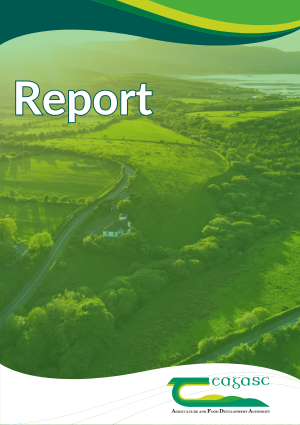
External Assessment of Teagasc’s Clover and Mult-Species Sward Research Programme
26 March 2025
Type Report
Type Report
The purpose of this review was to assess a portfolio of research and associated knowledge transfer documentation summarising results of animal-based studies on Perennial Ryegrass /White Clover, Perennial Ryegrass/Red clover and Multi-Species Swards undertaken by Teagasc over the last fifteen years.
Download Publication (PDF)
Key Recommendations
- Given the scale and cross-centre, cross-programme nature of PRG/WC and MSS research within Teagasc, it is recommended that consideration should be given to establishing a PRG/WC and MSS Research Co-ordination Group to co-ordinate all aspects of research, and to develop appropriate platforms for future research in this area (e.g.Future Sward Platform).
- The wide variation in performance of PRG/WC swards is a major concern and highlights the need for more detailed research on factors influencing Biological N Fixation (BNF).Research should aim to quantify and understand the factors that influence BNF from white clover under a range of sward conditions and soil types.
- The primary justification for applying Fert N to PRG/WC swards relates to concerns re poor early spring growth with these swards. Further research is needed to develop Fert N recommendations based on the plant available N required to support herbage yield at specific time points in the season. The new Teagasc PRG/WC herbagegrowth model being developed at present could provide a good basis for developing Fert N recommendations for PRG/WC swards. The model needs to consider variables such as clover content, soil temperature, soil type, geographic location, legacy N from the previous autumn, manure N (slurry N and recycled N from grazing animals) herbage yield and soil N mineralization.
- There is evidence of differences between clover varieties in N fixing ability and tolerance to competition within a mixed PRG/WC sward.Research is ongoing within Teagasc to develop a Clover Profit Index and this work should examine possible varietal differences in spring growth characteristics potentially related to onset of N fixation.Research into the effects of WC cultivars and the interactions with grass variety and Fert N application should also be a priority area for research going forward.
- Further research is needed to quantify the impact of PRG/WC versus PRG + Fert N swards, on GHG and ammonia emissions and nitrate leaching across a range of soil types, using the improved recommendations for Fert Non PRG/WC swards being developed under 3 above.
- Reliable establishment of PRG/WC swards remains a challenge on some farms and further research is needed to develop best management practices for grazing management in the first year of establishment, across a range of soil types. Further research is also reis also required on best practice for maintaining a high proportion of white clover in the sward using strategic over sowing;
- Whilst there has been limited adoption of PRG/WC on dairy farms, uptake on beef and sheep farms has been much slower, despite the much lower levels of Fert N being used. Given the relatively limited use of rotational grazing on beef and sheep farms, further research is needed to examine the role of PRG/WC under alternative grazing systems, including the potential of zero Fert N systems.
- From the limited number of long-term scientific studies undertaken to date, across both Teagasc and UCD, there is insufficient evidence to support the use of MSS in farm practice,particularly in relation to agronomic or animal performance benefits when compared with PRG/WC swards. However, there is some evidence of potential environmental impacts–particularly in relation to reduced N losses. On this basis, further research on MSS is justified with specific emphasis on accurately quantifying environmental impacts and determining whether similar benefits can be obtained with a reduced number of species, for example a simple PRG/WC/Plantain mix. Sward proportions required to improve environmental outcomes need to be achievable and demonstrated at farm level across multiple years.
- Research is required to improve the establishment and persistency of MSS. This work should incorporate herb cultivar evaluation and compatibility with grasses and legumes as most of the research studies to date have used a single Plantain cultivar. The work should also investigate cultivar interactions with Fert N application and grazing management.
- Further research is required to evaluate grazing management strategies more suited to MSS, whilst maintaining legume content in the sward (potentially with red clover rather than white clover), and the persistency of these swards needs to be examined. The role of MSS under drought conditions also requires further investigation.
- Further research on PRG/RC swards for silage production should focus on opportunities to maximise the use of manure N as the primary source of N and to evaluate varietaldifferences in yield potential and persistencyinlonger term studies (5–10years).
